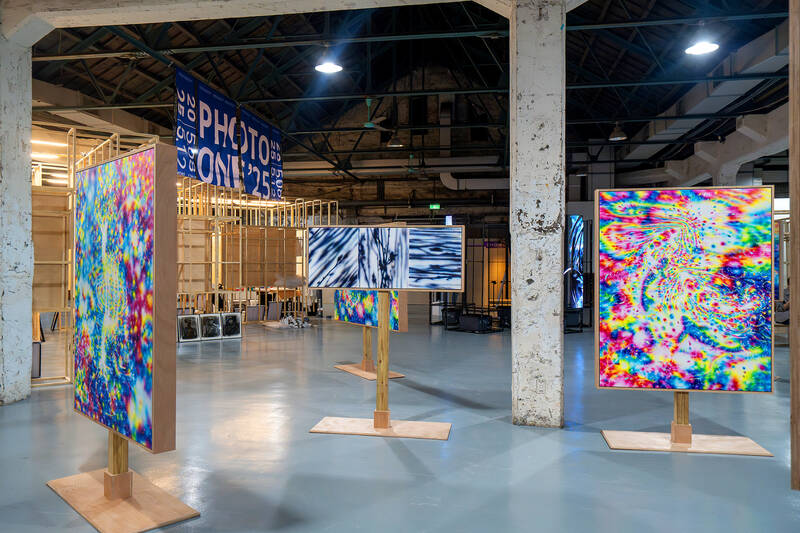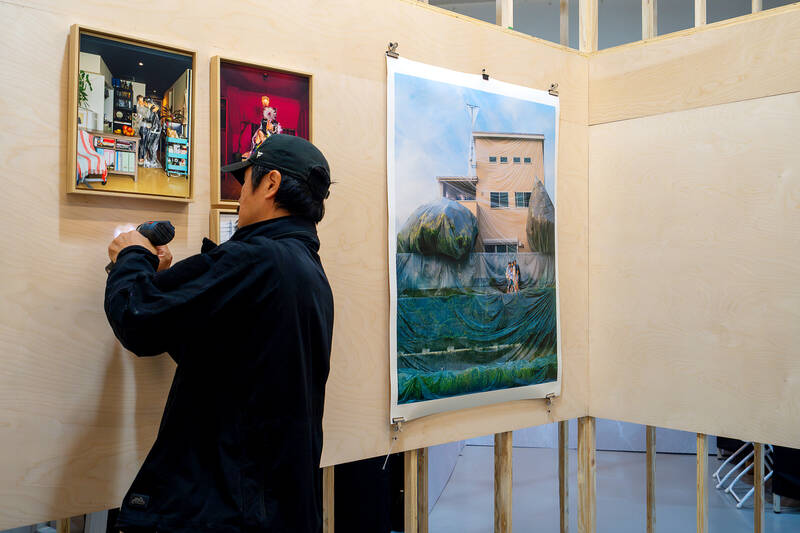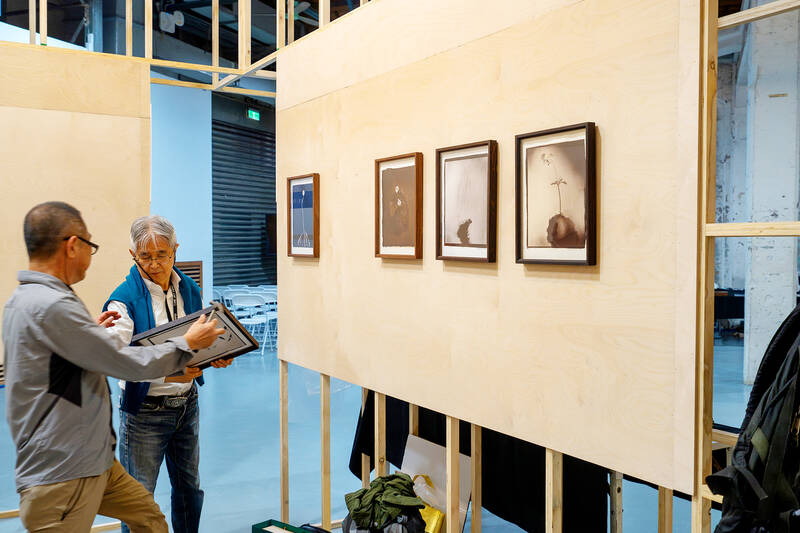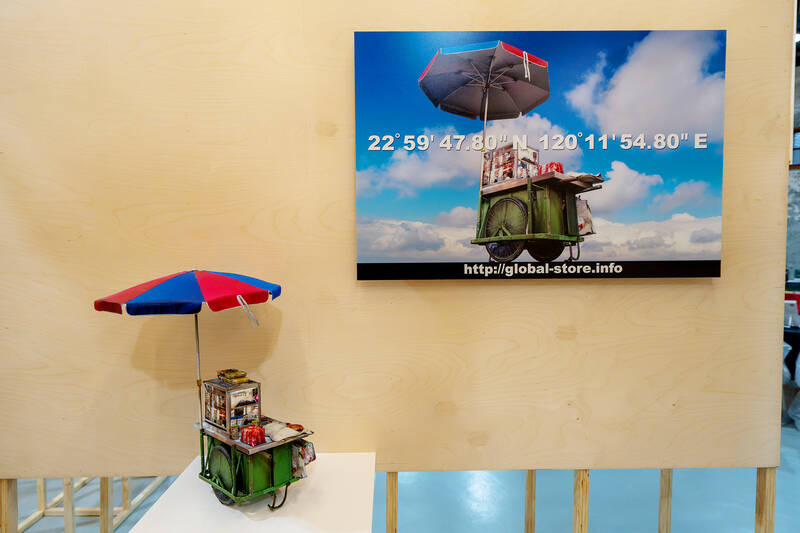This weekend, Huashan 1914 Creative Park plays hosts to a joint art exhibition “Voices 2025 x Photo ONE’25.”
The Taipei Times was invited on Wednesday to see the artists and exhibitors set up tables, art installations, hang picture frames and prepare for what organizers hope will be a popular event.
Occupying two distinct halves yet coming together in a shared space, the event showcases a wonderful mix of art, from photography to sculptures and interdisciplinary displays.

Photo: Lery Hiciano, Taipei Times
Photo ONE’25, on the right side of the event space, in buildings E2 A, B and C, is a showcase of eight individual galleries and dozens of artists, as well as tables of publishers selling photography books, magazines and even match boxes.
The artists represent not just Taiwan, but South Korea, Hong Kong and Japan as well, all bringing their unique perspectives for photography.
Themes and subject matter include food, tattooed gangsters and experimental depictions of relationships.

Photo: Lery Hiciano, Taipei Times
Shen Chao-liang (沈昭良), who serves as the event’s convener and led the pre-release gallery tour, has some of his most famous photographs on display from his series on Tokyo’s former Tsukiji Fish Market (築地魚市場).
ARTHIS Fine Art gallery displays a collection of black and white photographs from two Taiwanese photographers, Chih Huei-chang (張志輝) and the late Chang Chao-tang (張照堂).
Chih’s work leans toward landscapes, albeit moody, almost discomforting depictions of the natural world, while Chang’s photographs are surreal and open to the viewer’s interpretation.

Photo: Lery Hiciano, Taipei Times
One eye-catching exhibition is miniatures of stores, in all shapes and sizes, by Takahiko Suzuki.
Each store is represented as a recreation, an amalgamation of hundreds of digital images stitched together, alongside a large white poster of itself with the coordinates written across the sky.
A Web site then provides direction to the store from the viewers’ location.

Photo: Lery Hiciano, Taipei Times
Some of the stores are tiny stalls, others resemble churches, but the stereoscopic recreation perfectly straddles the line between authentic representations and works of art.
Each store is purposefully placed against a blue sky, a blank background, allowing for the viewer to visualize exactly where they would come across the store, what the owner looks like, how the food smells.
Japan’s Haruhiko Kawaguchi, part of the Gallery Tosei exhibit, set up his collection of photographs in which people interact with each other while wrapped in plastic, in contact but unable to bridge gaps between one another.
“Any questions?” he asked rhetorically with a smirk.
A family stands wrapped in plastic, much like a package, in front of their home and garden, also wrapped in plastic, two women kiss but are unable to interact with their environment; two people sit in a children’s playground, almost alien in how incongruous they are in contrast to their surroundings. His photographs speak for themselves, highlighting the barriers, often artificial, that separate us from our loved ones and our environments.
Moving away from the photography galleries, Tomoya Tsukamoto’s “Journey of Encounters” are the next stop.
Each individual piece is an expressive, larger than life, airbrushed canvas.
“This exhibition is an experiment in visualizing intersecting moments,” Tsukamoto said in an Instagram post promoting the event.
The kaleidoscope imagery of each work is made through airbrushing flowers and their petals, leaving behind white silhouettes against colorful backdrops.
While each individual work is visually interesting on its own, when taken together they create an effect to provide depth and meaning to the space.
Moving closer and standing further away both evoke different sensations in the viewer, a layered ethereal dynamic that speaks to the artist’s sense of space and detail.
Another non-photography collection of art is by Liu Hsin-ying (劉昕穎), presented by Taipei’s AKI Gallery.
Liu’s art is abstract, meant to resemble not just abstract landscapes but also represent specific moments, as seen in the bright red stalks in Straight to the Sky (直達天際) or the textures within Stars Scattered in the Dark Night Forest (星星灑落在黑夜的森林).
In addition to the exhibits, the galleries and artists will hold speaking sessions, award ceremonies and book signings throughout Saturday and Sunday afternoon.

US President Donald Trump may have hoped for an impromptu talk with his old friend Kim Jong-un during a recent trip to Asia, but analysts say the increasingly emboldened North Korean despot had few good reasons to join the photo-op. Trump sent repeated overtures to Kim during his barnstorming tour of Asia, saying he was “100 percent” open to a meeting and even bucking decades of US policy by conceding that North Korea was “sort of a nuclear power.” But Pyongyang kept mum on the invitation, instead firing off missiles and sending its foreign minister to Russia and Belarus, with whom it

Many people noticed the flood of pro-China propaganda across a number of venues in recent weeks that looks like a coordinated assault on US Taiwan policy. It does look like an effort intended to influence the US before the meeting between US President Donald Trump and Chinese dictator Xi Jinping (習近平) over the weekend. Jennifer Kavanagh’s piece in the New York Times in September appears to be the opening strike of the current campaign. She followed up last week in the Lowy Interpreter, blaming the US for causing the PRC to escalate in the Philippines and Taiwan, saying that as

When Taiwan was battered by storms this summer, the only crumb of comfort I could take was knowing that some advice I’d drafted several weeks earlier had been correct. Regarding the Southern Cross-Island Highway (南橫公路), a spectacular high-elevation route connecting Taiwan’s southwest with the country’s southeast, I’d written: “The precarious existence of this road cannot be overstated; those hoping to drive or ride all the way across should have a backup plan.” As this article was going to press, the middle section of the highway, between Meishankou (梅山口) in Kaohsiung and Siangyang (向陽) in Taitung County, was still closed to outsiders

The Chinese Communist Party (CCP) has a dystopian, radical and dangerous conception of itself. Few are aware of this very fundamental difference between how they view power and how the rest of the world does. Even those of us who have lived in China sometimes fall back into the trap of viewing it through the lens of the power relationships common throughout the rest of the world, instead of understanding the CCP as it conceives of itself. Broadly speaking, the concepts of the people, race, culture, civilization, nation, government and religion are separate, though often overlapping and intertwined. A government